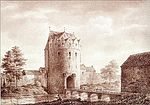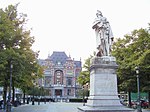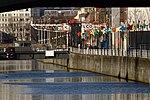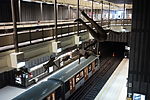Brussels Shot Tower
Belgian building and structure stubsCity of BrusselsProtected heritage sites in BrusselsShot towers

The Brussels Shot Tower is a shot tower located in Brussels, Belgium. It was built in 1898 at the site of a former gunpowder factory that dated back to 1832. The shot tower was used until 1962, making the last one to remain in use in Belgium. It was classified as a National Heritage Site (number 2043-0092/0) in 1984.The round brick structure is 46 metres (151 ft) high. At its base, it is 4.7 metres (15 ft) in diameter, narrowing to 3.1 metres (10 ft) at the top. It originally had a lantern at the top, and a dome with a weathervane on it.
Excerpt from the Wikipedia article Brussels Shot Tower (License: CC BY-SA 3.0, Authors, Images).Brussels Shot Tower
Rue de l'Abattoir - Slachthuisstraat, City of Brussels Pentagon (Brussels)
Geographical coordinates (GPS) Address Nearby Places Show on map
Geographical coordinates (GPS)
| Latitude | Longitude |
|---|---|
| N 50.84826 ° | E 4.3396 ° |
Address
Centre Tour à Plomb - Centrum Hageltoren
Rue de l'Abattoir - Slachthuisstraat 24
1000 City of Brussels, Pentagon (Brussels)
Belgium
Open on Google Maps






